Snow falls soft and fast as I speed down Highway 36. It’s 7:20 in the morning and I’m on my way to work, driving my Subaru from Denver to Boulder like so many other commuting Coloradans.
On the crest of hill overlooking the city, two cow pastures break the monotony of shopping plazas and housing developments that line the highway for miles. A dark shape trots across one of them, silhouetted against the white snow. I coast past it, not bothering to sneak a better look as I monitor the blur of traffic around me.
It’s just another coyote.
I wasn’t always so quick to dismiss urban wildlife. I spent my childhood in central Florida kayaking past alligators, peeling sticky green tree frogs off the windows, and watching baby barred owls vomit up pellets onto our lawn. Mom would yell “Otters!” up the stairwell, and my brother and I would come bounding down to watch them cavort around the dock, time after time. We never got tired of watching the backyard menagerie.
But I always thought of my childhood as an exception: we lived in an old neighborhood bordering a lake and my father lovingly filled our large backyard with as many native species as possible. It was suburbia, but there was still a wildness lurking around the edges, if you knew where to look. (Or maybe it was just Florida.)
Since then I’ve lived my entire adult life in much more urban spaces. Subway rats passed for wildlife in Manhattan and Washington DC, while in Denver the only backyard wildlife I ever saw, aside from the highway coyotes, were feral cats and the occasional crow. There were exceptions, notably spring bird migration in city parks, but then again a passing migration twice a year didn’t seem to count.
And so urban wildlife became less of a reality and more of a buzzword. Something that conservationists talk about, but not something that I valued or sought out.
But that all changed when I moved across the world to Australia five months ago, where a terrifying possum helped me rediscover my wild backyard once again.
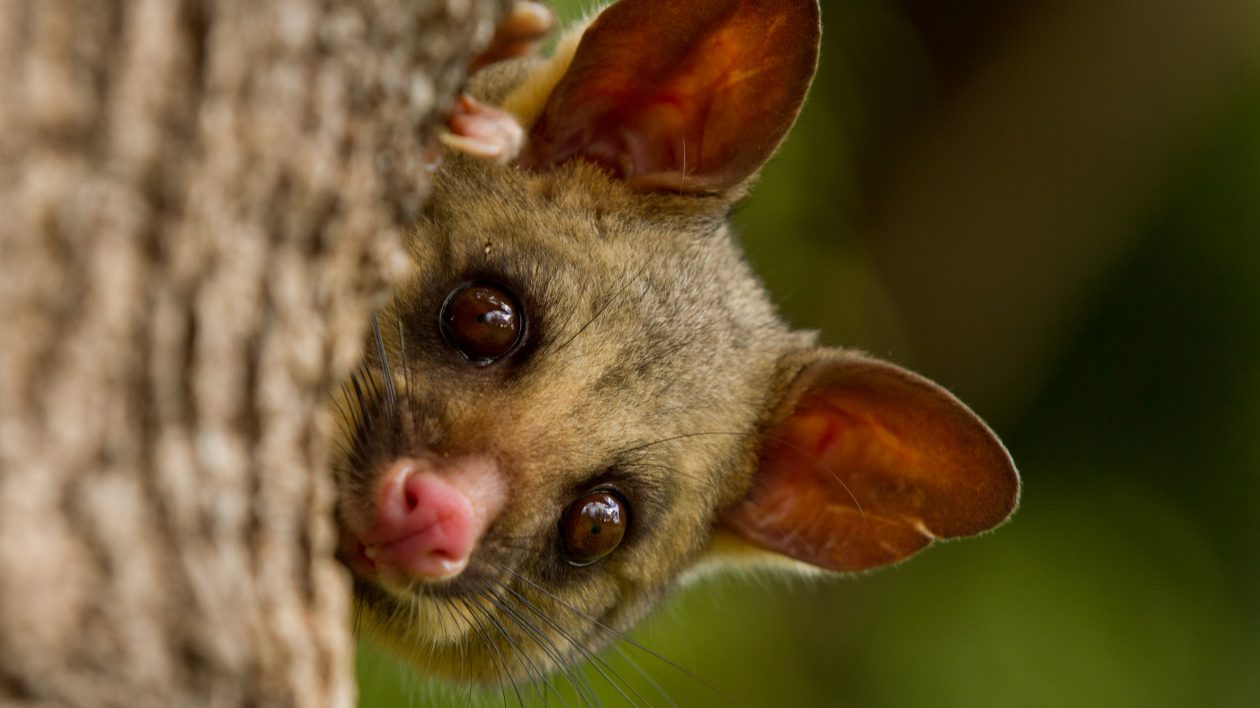
Marsupial Night Terrors
My first night in Oz was not a restful one. After weeks of frantic moving logistics, 17 hours in the air, and a day setting up a new cell phone and bank accounts… I was absolutely exhausted. I collapsed into bed, grateful that a co-worker had let me house-sit for the week, and fell asleep instantly.
But just an hour later I awoke to a deafening crash directly over my head. Then another crash, this time from the other side of the house. And then a blood-curdling shriek, followed by a series of loud bangs running across the length of the tin roof.
Convinced that the house was being robbed or I was experiencing an Ambien-induced hallucination — or quite possibly both — I grabbed a mini bottle of pepper spray from my purse and staggered into the living room. Silence. And then another crash, this time from the porch. Creeping up to the glass door, I flicked on the light switch. Staring back at me from the picnic table — equally startled — was a fat, fuzzy possum.
Well, I certainly wasn’t in Kansas anymore.
The nighttime possum terrors continued all week: crashes, thumps, scratches, and a chorus of growls, grunts, screeches, hissing, and chattering. The culprit was the common brushtail possum, an impossibly adorable little marsupial with big brown eyes, a wet pink nose, perky ears, and a coat fluffier than a golden retriever puppy.
I soon learned that brushtails love to den in walls, roofs, or ceilings of urban structures, even preferring these man-made structures over tree hollows.
When I regaled my coworker with the story of my night of possum terrors, he simply laughed and said: “Oh, that must have been Bitey.” When I stared at him blankly, he explained that his house is actually inhabited by no fewer than three possums — nicknamed Bitey, Scratchy, and Shrieky — who have frequent raucous brawls on the roof.
Thanks for the warning, mate.
Avian Alarm Clocks and Brazen Brushturkeys
As the weeks went on and I settled into my new life in Brisbane, I started to notice all sorts of furred, feathered, and scaled neighbors creeping about the city.
Living in an apartment spares me from more nighttime possum wrestling, but my sleep is still subject to the whims of wildlife. Every single morning I wake up well before dawn to an ear-splitting assemblage of Aussie birds.
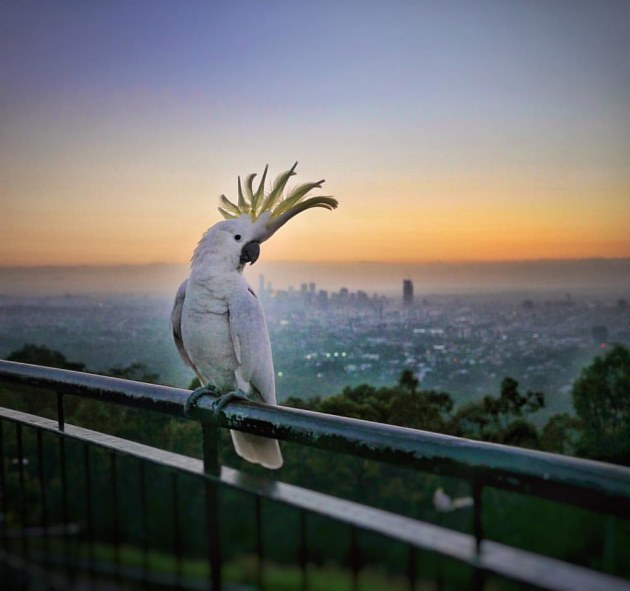
Some days it’s the garrulous howling of the blue-winged kookaburra punctuated by shrieks from the sulphur-crested cockatoos. Other days it’s a wardling chorus of Australian magpies and pied currawongs.
The first morning this chorus filled me with a deep, welling sense of joy. I was finally here, a place I had so long dreamed of living. By the second morning I was swearing. And by the third morning — when the currawong chose to sit directly outside of my window — I was convinced that they were deliberately torturing me.
Other birdlife is less irritating, but considerably more ugly. Often I’ll look out the window to see a brushturkey trundling amid the landscaping outside of my building. These massive, turkey-like birds are megapodes, a family of birds that incubate their eggs in a pile of vegetation, just like alligators and crocodiles. (You can read more about brushturkeys here.) With featherless, scarlet heads, knobbly yellow wattles, and massive clawed feet, they look like they accidentally wandered off the set of Jurassic Park.
I’d seen first brushturkeys on earlier trip to Queensland, shuffling about in the fantastic, primordial rainforests that line Australia’s eastern coastline. But now I spot them waddling brazenly down the sidewalk, sending the neighborhood cats running. I’ve seen them stop traffic on streets busy streets, forage in the shadow of downtown’s skyscrapers, raid community garden compost piles, and perch nonchalantly in the trees over a backyard pool.
Like the honey badger, brushturkeys just don’t care.
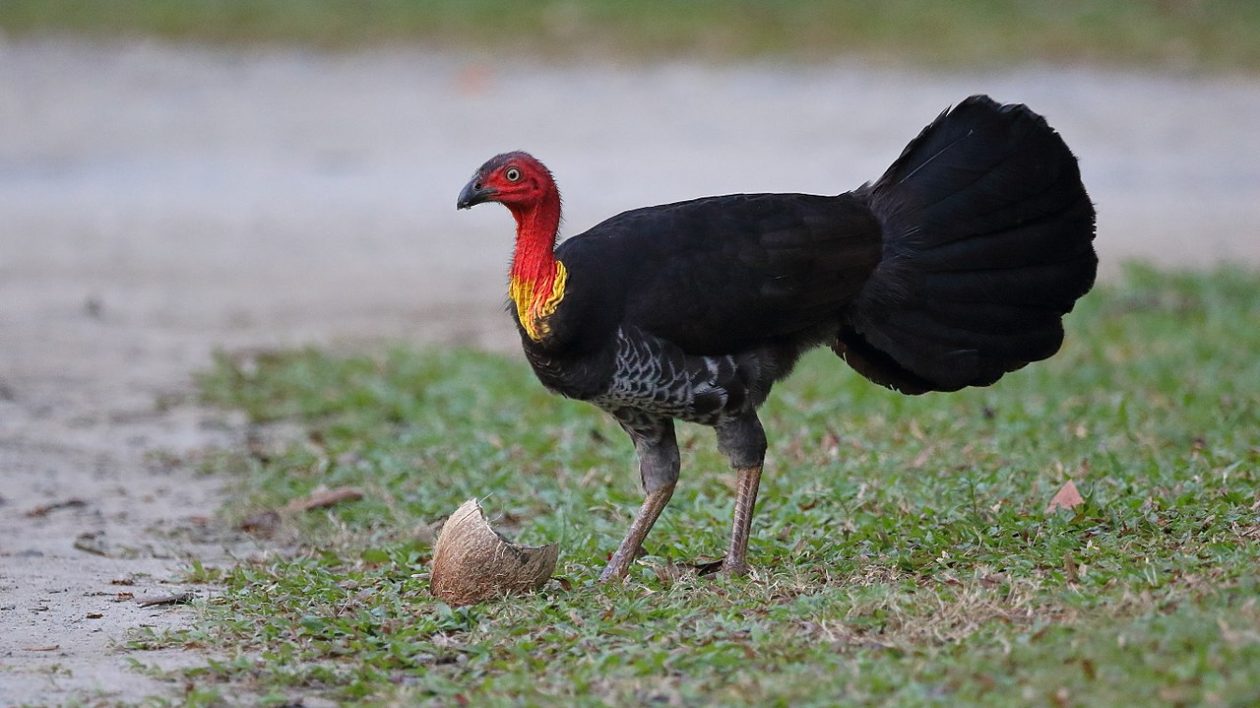
A New Perspective
In a new setting, it seems like wildlife lurks everywhere. If I walk outside at dusk and shine a flashlight up onto the telephone poles, chances are I’ll see a second possum species — a ringtail possum — scampering along the power lines. Or I’ll spot the silhouette of a massive flying fox cruising over the supermarket.
On my daily commute to work along the Brisbane river, two-foot-long eastern water dragons scuttle beneath the city landscaping, while warning signs stapled to the telephone poles warn of dangerous swooping magpies defending their nest nearby.
I have yet to find a carpet python in my toilet or a humongous huntsman spider hiding in my mailbox, but it’s only a matter of time.
At first, this assemblage of urban wildlife was just a delightful, strange novelty. Like putting beets on a burger or greeting people with “G’day, mate!”, it was just one part of the adventure that is living in Australia.
But something more significant was at work. It wasn’t just novelty, it was a new perspective. Without the familiar flora and fauna of the first 30 years of my life, I was looking at the city with a fresh set of eyes. I could see that same wildness I found in Florida, so many years ago.
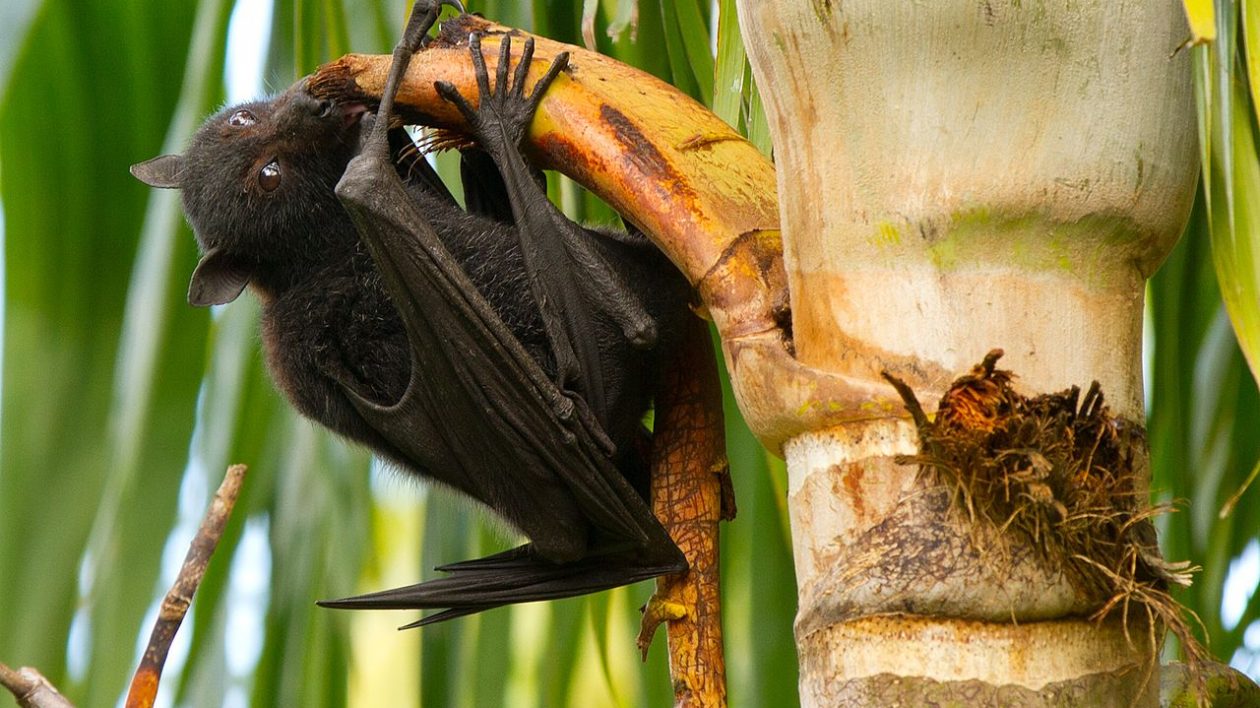
Perhaps it was easy for me to write off the disappearance of urban wildlife in my life because the experience so is common. Witnessing the wild nature of one’s childhood disappear to urban sprawl is the archetypal conservation story… an experience so universal amongst conservationists that our grief acts as a common language.
But in our grief, I think we fail to appreciate the wildlife that does remain, right beneath our feet or above our heads.
Conservationists talk about the value of “regreening” and “urban wildlife” and then spend our vacations seeking out “real” wildlife in decidedly more pristine areas. I’m no exception: in the last two years I’ve spent my vacations seeking out puma in Patagonia and fawning over toucans and sloths in Costa Rica.
When it comes to wildlife, it seems that familiarity breeds contempt — or at least boredom. Charismatic megafauna derive much of their charisma by being rare, exotic, and difficult to see. (No one would boast about seeing a tiger if they were often seen rummaging through suburban garbage like raccoons.)
But really I’d just forgotten that raccoons are pretty darn cool. It’s downright astounding that brushturkeys are just as comfortable scratching for food amid the meager urban landscaping as they are in the rich rainforest. That coyotes can co-exist with highways, or that there could be a possum lurking under every roof.
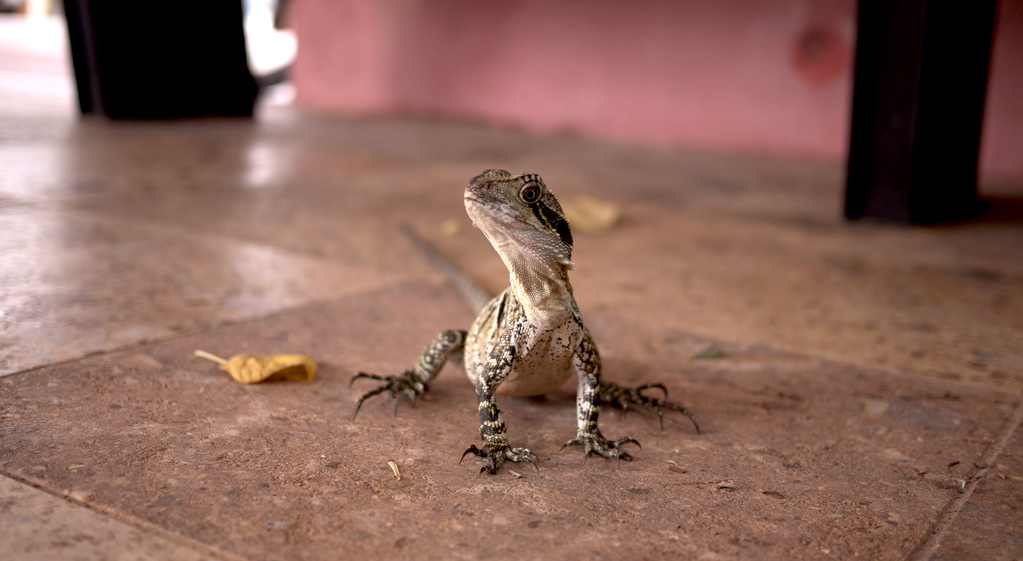
I should note that not all Australian wildlife is faring so well. We should celebrate urban wildlife, but also recognize that many species simply can’t adapt to cities and the new habitats created by humanity. Invasive cats and foxes are eating their way through the outback, causing catastrophic declines (and even extinctions) of native marsupials. My home state of Queensland is one of the world’s greatest deforestation hotspots, mowing down forests at rates that rival the Brazilian Amazon or Indonesia and killing an estimated 34 million native animals every year.
All of which makes it even more remarkable that a few species — the brushtails and brush turkeys, cockatoos and currawongs — are thriving alongside us. Remnants of the wild are still there, lurking under our roofs or in our backyards. But only if we remember to look for them.
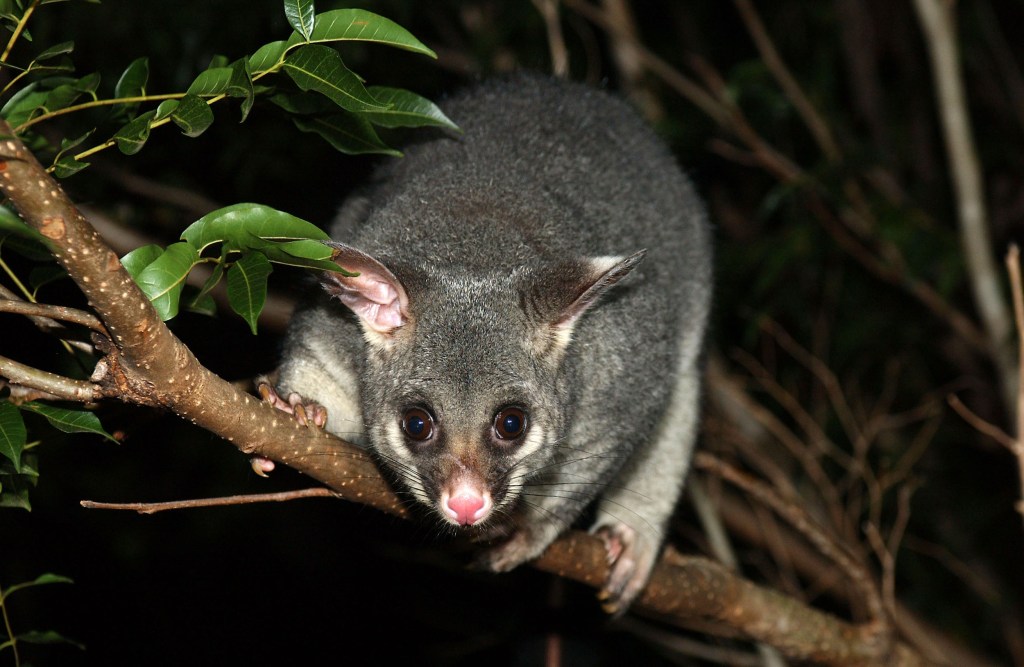



Just read something from one of the environmental blogs – regarding several efforts in Calif. to spread more develop into “fire-hazard” areas! To remove forests in order to have another vineyard! To build homes nearer & nearer to a Preserve. Apparently, nothing has been learned after season after season of wildfires. How sad that counties & cities dont regulate & prevent this. (too much money, I guess)
Its the wildlife and their habitat – the voiceless – who suffer. Seriously, what kind of world will it be when we have eradicated the rest (60% gone) of the native species? That seems to be the direction the most recent occupier of the WH is going in. As he says – SAD!
I miss my childhood of nature too.I miss Calif, San Diego specifically. Theirs lots of the smaller wildlife there. I live in New Mexico now and there’s not nearly as many birds or rodents or lizards, etc as Southern Ca. It sadden’s me that wildlife and the natural habitant is disappearing everywhere in the world.
I grew up in St. Petersburg, Florida during the 50’s and most of the 60’s. Four blocks from my house was a lake mostly bordered by manicured grass, sidewalks, and green park benches. Somehow the Southern shoreline had been saved from being “developed” and became a joyful part of my boyhood. As a youngster just discovering the art of fishing I learned to handle a cane pole and became proficient at catching Bluegill.
The Southern shoreline of Crescent Lake was my first real view of nature as it should be. Stands of bamboo and willow, and the occasional Banyan tree, decorated it’s shoreline. We swam near a spring-fed Banyan tree that was as big as a house. I played with tadpoles , frogs , red-eared turtles and during the spawn was able to, ever so slowly, feel my way through the submerged roots of trees along the bank and catch bluegill with my bare hands. Alligators would find their way through the storm sewers from Lake Maggiore, six miles away, and would have to be removed. I think it had to do with people’s pets disappearing.
Once each year Hickory Shad would migrate into the lake from Tampa Bay via the storm sewers in order to spawn. They would be stacked like cordwood and could be tempted to take a tiny dough-ball skewered onto the tip of a small hook. They were more fun to catch than the bluegill because they were larger and fought harder. We were told that they weren’t good to eat because they were so bony. It was years later that I discovered the pleasure of eating grilled shad roe.
I remember marveling at Black Skimmers gliding across the lake’s surface at dusk with their odd shaped bills searching for fish just under the surface.
After starting High school I didn’t visit the lake for some time until one day while driving past my childhood paradise I discovered that the city had cleared out all of the natural habitat and turned it into a sterile grass covered imitation, complete with the sidewalks and green benches. It was a very sad and traumatic experience for me; almost as bad as the day Trump got elected. To this day I do not know why this happened.
Since that day the lake has gone downhill and become a depressing wasteland. Over the years the storm sewers drained chemically tainted water into my lake. The big Banyan tree is half the size it was during it’s prime and is obviously dying. I saw “No Fishing” signs posted around the lake and discovered that the algae filled water had been stocked with Tilapia. Tilapia! God help us all!
This destruction of habitat has repeated itself in the small spring-fed suburban lakes across Florida.
How can the “Developers” call themselves “Developers”? A bit of a misnomer, don’t you think?
George Lazar
Sacramento, Ca.
I, too, love to watch the wildlife in my backyard in a 60-year old neighborhood with mature trees & lush landscape (flood irrigation from original agricultural zoning) here in the Southwest Desert of Tempe, Arizona (east of Phoenix). We have planted lots of native & desert-adapted shrubs & flowers so have lots of pollinators, hummingbirds, & even a Hermit Thrush that visits every winter along with other migrating birds, butterflies & moths. Also tree lizards, geckos, even resident Grey Foxes in nearby neighborhoods. But nothing quite as exciting as in Queensland! Thanks for teaching us all to just pay attention!
You’re so lucky to see all this wildlife.
Great article, educational as from Lees Summit, Mo!
So! Good! Thanks for this. Such a great read. Beautiful animals trying to survive are everywhere. Thanks for the solid and entertaining information on quite a number of them.
In Brooklyn, my 84-year-old neighbor has a possum in her kitchen wall, and the energy of the universe lands me on your “Possum Terrors” article. Amazing.
Have been trying to help her while also talk her out of poisoning it. Tonight, she and her grandson are going to try to lure it out of its “new home” in the hole behind her stove and close the door behind the critter if they succeed. Will soon hear, but at least she seems to have taken poison off of the table as her go-to solution.
Not that it matters, but the “extenuating” circumstances of her situation are that she doesn’t want to pay for a wildlife control service and due to what she considers a kitchen not suited for guests, she won’t let me in that room of her house to join up.
Hey Curtis, why not share this article with your neighbor? She might develop a different mindset!
Wow! Thank you Justine, for your insights and comments on “urban wildlife” in Brisbane that we didn’t know about! The black flying fox looks like a bat! And the possums are WAY cuter than ours in San Diego!
“When it comes to wildlife, it seems that familiarity breeds contempt — or at least boredom. Charismatic megafauna derive much of their charisma by being rare, exotic, and difficult to see. (No one would boast about seeing a tiger if they were often seen rummaging through suburban garbage like raccoons.)” BEAUTIFULLY put!!! I live in NE rural Nebraska and the whole “See a COYOTE/RACCOON-KILL a COYOTE/RACCOON” prevalent attitude has always REALLY aggravated me! We moved into THEIR habitat!!! THEY were here FIRST!!! But people don’t like to HEAR that! My attitude of “I’d rather deal with animals!” Began EARLY… and it’s ONLY gotten STRONGER and more STUBBORNLY ENTRENCHED over time!!! Thank you for this article! <3
Wonderful story! Finding the childhood delights of our animal world as adults is so special. I hope this article encourages all of us to look for our four legged or winged neighbors every where we live. I myself, rescued a common newt the other day! He would have died without my help. Makes you want to save all the critters we have so carelessly pushed aside. Big or small , we need them!